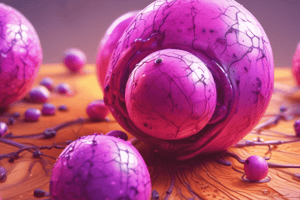Podcast
Questions and Answers
What percentage of all testicular tumors are germ cell tumors?
What percentage of all testicular tumors are germ cell tumors?
- 50%
- 95%
- 90-92% (correct)
- 80%
All intratesticular masses should be considered benign.
All intratesticular masses should be considered benign.
False (B)
What is the most common type of germ cell tumor?
What is the most common type of germ cell tumor?
Seminoma
The majority of malignant testicular tumors originate from __________.
The majority of malignant testicular tumors originate from __________.
Which of the following is NOT a type of non-seminomatous germ cell tumor?
Which of the following is NOT a type of non-seminomatous germ cell tumor?
What are the primary sonographic features of a seminoma?
What are the primary sonographic features of a seminoma?
Choriocarcinoma has the worst prognosis among germ cell tumors.
Choriocarcinoma has the worst prognosis among germ cell tumors.
At what age range do non-seminomatous germ cell tumors typically occur?
At what age range do non-seminomatous germ cell tumors typically occur?
Match the following germ cell tumors with their characteristics:
Match the following germ cell tumors with their characteristics:
Leukemia is the most common metastatic testicular neoplasm.
Leukemia is the most common metastatic testicular neoplasm.
What is the sonographic feature of lymphoma metastasis to the testes?
What is the sonographic feature of lymphoma metastasis to the testes?
Flashcards are hidden until you start studying
Study Notes
Malignant Testicular Masses Overview
- Most extra testicular (ET) masses are benign, while all intratesticular (IT) masses should be considered malignant.
- Common presentation includes painless unilateral testicular masses or diffuse enlargement.
- 90-95% of testicular cancers are of germ cell origin and are highly malignant.
- Higher incidence observed in individuals with cryptorchidism (undescended testicles).
- Sonography effectively diagnoses intratesticular masses and distinguishes from extratesticular diseases.
Germ Cell Tumors (GCT)
- Account for 90-92% of all testicular tumors, with 95% being malignant IT tumors.
- Types include:
- Seminoma: Most common, radiosensitive, peaks in 4th and 5th decades, confined within the tunica albuginea, and has a favorable prognosis.
- Non-seminomatous Germ Cell Tumors (NSGCT): More aggressive than seminomas, invade tunica albuginea, and often produce hormones.
Seminoma
- Comprises 50% of primary testicular neoplasms, usually hypoechoic, homogeneous, and smooth on ultrasound.
- Normal levels of alpha-fetoprotein (AFP) in pure seminomas.
Non-Seminomatous Germ Cell Tumors
- Includes:
- Embryonal Cell Carcinoma: Most aggressive, occurs in men aged 25-35, presents with elevated AFP and beta-hCG.
- Choriocarcinoma: Rarest GCT with the worst prognosis; presents with signs of hemorrhagic metastases and gynecomastia.
- Yolk Sac Tumors: Comprise 80% of childhood testicular tumors (in children <2 years), with elevated AFP.
- Teratoma: Contains multiple tissue elements, usually benign in infants but malignant in adults. Sonographically inhomogeneous with calcifications.
- Mixed Germ Cell Tumors: Comprise up to 60% of GCT, often have embryonal cell carcinoma as the primary component.
Regessed (Burned-Out) Germ Cell Tumors
- Metastatic disease from primary tumor that has regressed.
- Variable sonographic appearance, also known as "Azzopardi tumors."
Non-Germ Cell Tumors
- Gonadal Stromal Tumors:
- Leydig Cell Tumors: Common in men aged 20-50.
- Sertoli Cell Tumors: May cause gynecomastia and impotence, can be bilateral or malignant.
Metastatic Conditions
- Lymphoma: Most common metastatic testicular tumor, typically seen in older males (>60), presents as a painless mass.
- Leukemia: Second most common, may present bilaterally.
- Other Non-Lymphomatous Metastases: Rare; primarily from lung, prostate, melanoma, kidney, colon, stomach, and pancreas.
Key Sonographic Features
- Germ cell tumors generally appear as hypoechoic, homogeneous masses.
- Metastatic lesions may show diffuse involvement with variable echogenicity depending on the primary cancer type.
Studying That Suits You
Use AI to generate personalized quizzes and flashcards to suit your learning preferences.




